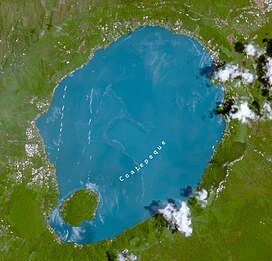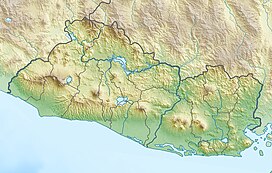| Coatepeque Caldera | |
|---|---|
 Satellite view of the Coatepeque Caldera | |
| Highest point | |
| Elevation | 746 m (2,448 ft)[1] |
| Coordinates | 13°52′N 89°33′W / 13.87°N 89.55°W |
| Dimensions | |
| Length | 7 km (4.3 mi) |
| Width | 10 km (6.2 mi) |
| Naming | |
| Native name | Cōātepēc (Pipil) |
| English translation | "at the snake hill" |
| Geography | |
| Country | El Salvador |
| Department | Santa Ana |
| Municipality | Coatepeque |
| Geology | |
| Formed by | Volcanic eruption |
| Mountain type(s) | Caldera, stratovolcanoes[1] |
| Rock type(s) | Rhyolite, Dacite, Andesite/Basaltic andesite |
| Volcanic arc | Central America Volcanic Arc |
| Last eruption | 72,000 and 57,000 years ago |
| Lake Coatepeque | |
| Lago de Coatepeque (Spanish) | |
 | |
| Location | Coatepeque, Santa Ana |
| Coordinates | 13°51′53″N 89°32′48″W / 13.864702°N 89.546800°W |
| Type | Caldera lake |
| Basin countries | El Salvador |
| Max. length | 7 km (4.3 mi)[2] |
| Max. width | 10 km (6.2 mi)[2] |
| Surface area | 10 sq mi (26 km2) |
| Average depth | 115 ft (35 m) |
| Max. depth | 115 m (377 ft) |
| Surface elevation | 745 m (2,444 ft) |
| Islands | Isla Teopán |
| References | [2] |
Coatepeque Caldera (Nawat: cōātepēc, "at the snake hill") is a volcanic caldera in El Salvador in Central America. The caldera was formed during a series of rhyolitic explosive eruptions from a group of stratovolcanoes between about 72,000 and 57,000 years ago. Since then, basaltic cinder cones and lava flows formed near the west edge of the caldera, and six rhyodacitic lava domes have formed. The youngest dome, Cerro Pacho, formed after 8000 BC.
- ^ a b "Global Volcanism Program | Coatepeque Caldera". Smithsonian Institution | Global Volcanism Program. Retrieved 13 April 2023.
- ^ a b c "Coatepeque Caldera - Location/Geological Setting". www.geo.mtu.edu. Retrieved 13 April 2023.
